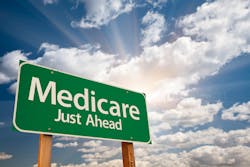On Tuesday, December 1, officials at the federal Centers for Medicare & Medicaid Services (CMS) announced changes to the Medicare payment system that will extend payment for more than 60 telehealth-delivered services, beyond the current public health emergency (PHE). The changes have been incorporated into the Calendar year 2021 Physician Fee Schedule final rule. CMS also announced changes that will affect the accountable care organizations (ACOs) participating in the Medicare Shared Savings Program (MSSP).
In a press release published to the agency’s website, CMS officials announced that:
“Today the Centers for Medicare & Medicaid Services (CMS) released the annual Physician Fee Schedule (PFS) final rule, prioritizing CMS’ investment in primary care and chronic disease management by increasing payments to physicians and other practitioners for the additional time they spend with patients, especially those with chronic conditions. The rule allows non-physician practitioners to provide the care they were trained and licensed to give, cutting red tape so healthcare professionals can practice at the top of their license and spend more time with patients instead of on unnecessary paperwork. This final rule takes steps to further implement President Trump’s Executive Order on Protecting and Improving Medicare for Our Nation’s Seniors including prioritizing the expansion of proven alternatives like telehealth.”
The press release quoted Health and Human Services Secretary Alex Azar as stating that, “During the COVID-19 pandemic, actions by the Trump Administration have unleashed an explosion in telehealth innovation, and we’re now moving to make many of these changes permanent,” said HHS Secretary Alex Azar. “Medicare beneficiaries will now be able to receive dozens of new services via telehealth, and we’ll keep exploring ways to deliver Americans access to healthcare in the setting that they and their doctor decide makes sense for them.”
And it quoted CMS Administrator Seema Verma as saying that “Telehealth has long been a priority for the Trump Administration, which is why we started paying for short virtual visits in rural areas long before the pandemic struck. But the pandemic accentuated just how transformative it could be, and several months in, it’s clear that the healthcare system has adapted seamlessly to a historic telehealth expansion that inaugurates a new era in healthcare delivery,” Verma said.
CMS officials noted that, “Before the COVID-19 public health emergency (PHE), only 15,000 fee-for-service beneficiaries each week received a Medicare telemedicine service. Since the beginning of the PHE, CMS has added 144 telehealth services such as emergency department visits, initial inpatient and nursing facility visits, and discharge day management services, that are covered by Medicare through the end of the PHE. These services were added to allow for safe access to important health care services during the PHE. As a result, preliminary data show that between mid-March and mid-October 2020, over 24.5 million out of 63 million beneficiaries and enrollees have received a Medicare telemedicine service during the PHE.”
And they added that “This final rule delivers on the President’s recent Executive Order on Improving Rural Health and Telehealth Access by adding more than 60 services to the Medicare telehealth list that will continue to be covered beyond the end of the PHE, and we will continue to gather more data and evaluate whether more services should be added in the future. These additions allow beneficiaries in rural areas who are in a medical facility (like a nursing home) to continue to have access to telehealth services such as certain types of emergency department visits, therapy services, and critical care services. Medicare does not have the statutory authority to pay for telehealth to beneficiaries outside of rural areas or, with certain exceptions, allow beneficiaries to receive telehealth in their home. However, this is an important step, and as a result, Medicare beneficiaries in rural areas will have more convenient access to healthcare. Additionally, CMS is announcing a commissioned study of its telehealth flexibilities provided during the COVID-19 PHE. The study will explore new opportunities for services where telehealth and virtual care supervision, and remote monitoring can be used to more efficiently bring care to patients and to enhance program integrity, whether they are being treated in the hospital or at home.”
Among the specific policy and payment changes being finalized:
> Certain non-physician practitioners such as nurse practitioners and physician assistants can supervise the performance of diagnostic tests within their scope of practice and state law, as they maintain required statutory relationships with supervising or collaborating physicians.
> Physical and occupational therapists will be able to delegate “maintenance therapy” – the ongoing care after a therapy program is established – to a therapy assistant.
> Physical and occupational therapists, speech-language pathologists, and other clinicians who directly bill Medicare can review and verify, rather than re-document, information already entered by other members of the clinical team into a patient’s medical record. As a result, practitioners have the flexibility to delegate certain types of care, reduce duplicative documentation, and supervise certain services they could not before, increasing access to care for Medicare beneficiaries.
The fact sheet on the CY Physician Fee Schedule Final Rule, which can be found here, includes the following important details involved in the Medicare Shared Savings Program (MSSP):
> CMS is finalizing changes to the Medicare Shared Savings Program (Shared Savings Program) quality performance standard and quality reporting requirements for performance years beginning on January 1, 2021 to align with Meaningful Measures, reduce reporting burden and focus on patient outcomes. For performance year 2020, CMS is finalizing to provide automatic full credit for CAHPS® patient experience of care surveys. For more information, please see the Quality Payment Program fact sheet.
> In response to new telehealth code policies finalized in this rule and to update the definition of primary care services used for beneficiary assignment to reflect the codes for assessment and care planning services for patients with cognitive impairment and chronic care management services, CMS is finalizing the inclusion of new evaluation and management and care management CPT and HCPCS codes in the methodology used to assign beneficiaries to ACOs. In addition, CMS is finalizing our proposals to exclude certain services furnished in skilled nursing facilities from the assignment methodology when provided by clinicians billing through FQHCs and RHCs, and to modify the definition of primary care services to exclude advance care planning CPT code 99497 and the add-on code 99498 when billed for services furnished in an inpatient care setting. CMS is also codifying our policy of adjusting an ACO’s historical benchmark to reflect any regulatory changes to the beneficiary assignment methodology in the regulations governing the benchmarking methodology.
> CMS is finalizing several policies that will further reduce burden associated with repayment mechanisms. Beginning with the application cycle for an agreement period starting on January 1, 2022 and annually thereafter, renewing ACOs and re-entering ACOs that are the same legal entities as ACOs that previously participated in the program, that wish to continue use of their existing repayment mechanism in a new agreement period may decrease their repayment mechanism amount if a higher amount is not needed for their new agreement period. The final rule includes a revised methodology for calculation of repayment mechanism amounts beginning with the application cycle for an agreement period starting on January 1, 2022, and annually thereafter. The final rule also offers a one-time opportunity for eligible ACOs that renewed their agreement periods beginning on July 1, 2019, or January 1, 2020, to elect to decrease the amount of their repayment mechanisms if the ACO’s recalculated repayment mechanism amount for performance year 2021 is less than their existing repayment mechanism amount.
> The interim final rule with comment period (IFC) issued by CMS on March 31, 2020, and the IFC issued by CMS on May 8, 2020, included provisions modifying or clarifying Shared Savings Program policies to address the impact of the PHE for COVID-19 on ACOs. In the CY 2021 PFS final rule, in response to public comments received, CMS is finalizing the Shared Savings Program provisions in these IFCs, with several modifications. CMS is revising the regulations specifying the adjustment to program calculations for episodes of care for treatment of COVID-19 to ensure greater consistency in the policies used to identify inpatient services provided by inpatient prospective payment system (IPPS) and non-IPPS providers that trigger an episode of care for treatment of COVID-19. CMS is finalizing the regulation specifying the expanded definition of primary care services for purposes of determining beneficiary assignment with modifications for greater consistency with the existing beneficiary assignment methodology. Specifically, CMS is are finalizing that the expanded definition, which includes telehealth codes for virtual check-ins, e-visits, and telephonic communication, will apply when the assignment window for a benchmark or performance year includes any months during the PHE for COVID-19 as defined in § 400.200. CMS is adding a provision specifying that the additional primary care service codes will be applied to all months of the assignment window (as defined in § 425.20), when the assignment window includes any month(s) of the COVID-19 PHE.
And, per the reference to the 2021 Quality Payment Program Proposed Fact Sheet above, CMS noted the following:
“As clinicians across the country continue to respond to the 2019 Coronavirus (COVID-19) pandemic, we recognize that the most important priority right now is ensuring patients are getting the care they need. We want to support this focus by limiting the number of significant changes to the Quality Payment Program in 2021, continuing a gradual implementation timeline for the Merit-based Incentive Payment System (MIPS) Value Pathways (MVPs), and introducing the Alternative Payment Model (APM) Performance Pathway (APP).
“We had previously finalized that participation through MIPS Value Pathways would begin with the 2021 performance period. However, we recognize stakeholder concerns about this timeline, even more so now that clinicians are working hard to address the spread of COVID-19 within their practices and communities. Therefore, we will not be introducing any MVPs into the program for the 2021 performance period. Instead we are proposing additions to the framework’s guiding principles and development criteria to support stakeholder engagement in co-developing MVPs and establishing a clear path for MVP candidates to be recommended through future rulemaking.
“Additionally, as we continue to make strides towards facilitating transition of clinicians from MIPS to APMs, we are proposing a new APM Performance Pathway (APP) reporting option in 2021 to align with the MVP framework. As part of the APP introduction, we will also be sunsetting the CMS Web Interface as a collection type beginning in the 2021 performance period. This change will significantly reduce the number of measures required to be reported by Accountable Care Organizations (ACOs) participating in the Medicare Shared Savings Program as well as groups and virtual groups that report through the CMS Web Interface as they transition to other collection types that offer greater choice. We believe working towards a future state of the program that is more aligned through these participation pathways will achieve our goal of moving away from siloed performance category activities and measures and moving towards sets of measurement options that are more relevant to a clinician’s scope of practice and that are meaningful to patient care.
“In light of the national public health emergency triggered by the COVID-19 pandemic, we limited our policy proposals to focus on the highest priorities for the program. In order to help us progress further towards the future state of MIPS, we have made some additional strides in furthering the MVP framework by proposing updates to the MVP guiding principles and additional guidance and structure that stakeholders should consider when collaborating with us on MVP creation. In addition, for the 2021 performance period, we have proposed some needed updates to both the MIPS and Advanced APM tracks to continue reducing burden, respond to feedback that we have heard from clinicians and stakeholders, and align with statutory requirements.”


